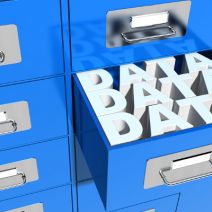 March 31st is World Backup Day! This occasion begs the question, “How much thought have you put into where your data is stored?” If you haven’t thought through your data storage options, then your files may be located in several different places. This could make accessing your data difficult, as well as jeopardize your network’s security. To get you started, let’s take a look at these four data storage options.
March 31st is World Backup Day! This occasion begs the question, “How much thought have you put into where your data is stored?” If you haven’t thought through your data storage options, then your files may be located in several different places. This could make accessing your data difficult, as well as jeopardize your network’s security. To get you started, let’s take a look at these four data storage options.
Infradapt Blog
 Your business relies on constant access to its data and information systems in order to maintain operations. Businesses that become victims of data loss disasters and are unable to recover their data, will more likely than not go out of business within one year of the incident, making it more important than ever to ensure that you have a plan in the event of the worst-case scenario. Would your business be able to get back on its feet following a data loss disaster?
Your business relies on constant access to its data and information systems in order to maintain operations. Businesses that become victims of data loss disasters and are unable to recover their data, will more likely than not go out of business within one year of the incident, making it more important than ever to ensure that you have a plan in the event of the worst-case scenario. Would your business be able to get back on its feet following a data loss disaster?
At times, backup and disaster recovery might seem like an unnecessary expense. Some business owners think that their systems are relatively safe from impending doom, so rather than focus on preserving existing information and infrastructure, they choose instead to implement new solutions that are designed to augment their income. Unfortunately, this hard-earned revenue will mean nothing if your data is lost due to unforeseeable circumstances that render your business inoperable.
One of the most common ways that a business can lose their data is through natural disasters. Depending on your business’s location, you could be subject to data loss from several different disasters. For example, people in areas that have exceptionally harsh winters understand the difficulties that come with heavy snow and ice accumulation, including infrastructure damage and downed power lines. Other locations are at risk of tornadoes, which are capable of completely destroying your office. Other types of natural disasters, like fires and electrical storms, are more common, but under the right circumstances, they are just as damaging as major storms. The lesson here: regardless of where you are in the world, a natural disaster could destroy your data, and maybe even your office.
If you add in the constant threat of hackers, who are unpredictable and can strike at any time, you could have an unexpected data loss disaster that’s difficult to recover from. Unlike a natural disaster, which exhibits warning signs, hackers will generally be discreet, being careful not to alert you to their presence. Hackers will steal and destroy your data with no concern for your business’s livelihood, seeking only to profit and benefit from your hard work. Look at the recent explosion of ransomware that has been threatening businesses. If they manage to get into your systems, it could spell trouble for your business in the form of hefty compliance fines, especially if you deal with personal credentials.
Another cause of data-loss that is often overlooked when it comes to planning is human error. Important files can be moved or even deleted altogether. Accidents like these are why it’s important to make sure that your employees understand the importance of following your best practices when using your network. Human error is also another reason it’s important to have a powerful back and disaster recovery solution.
With a backup and disaster recovery (BDR) solution from Infradapt, your business can minimize the downtime and data loss that’s often associated with unexpected hardware failure, natural disasters, and user error. A BDR can take multiple backups throughout the day, which are sent to both the cloud and a secure, off-site data center. The BDR minimizes downtime by acting as a temporary server in the event your current hardware fails to function properly. This gives your business adequate time to find a replacement.
When working with complex technology solutions, there are plenty of risks that need to be managed properly. Proactive IT solutions do this substantially better than the traditional break-fix IT model. Infradapt focuses on providing services that are designed to prevent issues from becoming more serious problems, like powerful security solutions that can detect threats to your infrastructure, and preventative maintenance.
Infradapt can provide all of the above managed IT services, plus some, all so your business doesn’t have to. For more information about business continuity and our BDR solution, give us a call today at 800.394.2301.
 Technology, while a great asset that can be leveraged for your benefit, can also frighten businesses due to how unpredictable it can be at times. The constant threat of data loss, identity theft, and hardware failure can cripple your business’s ability to retain operations. Specifically, businesses can learn about risk management by analyzing the processes used by an industry where risk management is absolutely critical: nuclear power plants.
Technology, while a great asset that can be leveraged for your benefit, can also frighten businesses due to how unpredictable it can be at times. The constant threat of data loss, identity theft, and hardware failure can cripple your business’s ability to retain operations. Specifically, businesses can learn about risk management by analyzing the processes used by an industry where risk management is absolutely critical: nuclear power plants.
 We live in a society where everything is always growing more powerful, and in turn, everything grows more complex. Nowhere is this more true than the technology industry. It’s easy to lose track of how much new technology you’ve added to your IT infrastructure over the years, but you know what they say; the more basic your infrastructure is, the better, for the sole purpose that it becomes much easier to maintain and manage. That said, redundancy actually makes things easier on your business continuity plan, instead of complicating it.
We live in a society where everything is always growing more powerful, and in turn, everything grows more complex. Nowhere is this more true than the technology industry. It’s easy to lose track of how much new technology you’ve added to your IT infrastructure over the years, but you know what they say; the more basic your infrastructure is, the better, for the sole purpose that it becomes much easier to maintain and manage. That said, redundancy actually makes things easier on your business continuity plan, instead of complicating it.
In IT, redundancy is actually a goal for your infrastructure. Redundancy pertains to data security and business continuity. Organizations want their data stored in multiple locations so as to make it easier to recover from potential issues that might come up. Essentially, achieving data redundancy is the same as taking proactive measures to keep your information safe in the event of a catastrophic data disaster, such as the failure of a mission-critical piece of hardware, or the theft of vital information from a hacking attack.
It’s important to take into account that most businesses who experience a deadly data disaster, and aren’t capable of recovering from it, will declare bankruptcy within a year of the incident. Your business basically has no choice but to ensure the redundancy of its data, and to make sure that it’s safe and secure from both internal and external threats, including data theft, user error, and especially hardware failure.
What your business needs to be taking advantage of is a comprehensive data backup and disaster recovery solution, specifically designed to augment a business continuity plan through redundant data storage. Your business needs to move forward knowing that in the worst-case scenario, you won’t lose your entire data infrastructure; instead, all you have to do is initiate a backup from the cloud, mitigating data loss and preventing downtime.
This is exactly what Infradapt’s backup and disaster recovery solution offers. Our BDR device is designed to offer a comprehensive data backup process and a seamless disaster recovery solution in one convenient package. You can have multiple backups take place throughout the day, and have these backups stored in off-site data centers and the cloud. You can shield your business from expensive and costly downtime by rapidly initiating your disaster recovery solution. In fact, in the event of a hardware failure or similar disaster, the deployment of your data occurs so quickly that the BDR device itself can temporarily take the place of your server, practically eliminating downtime while you search for replacement hardware.
For more information about how a BDR device can help your business’s data stay redundant and safe, give Infradapt a call at 800.394.2301.
 September was National Disaster Preparedness Month, and as such, it’s important to consider the state of your business’s current backup and disaster recovery practices. Different disasters pose various threats for your organization, but many of them have one thing in common: they’re going to ruin your physical IT infrastructure, and, depending on your backup practices, could potentially bring down your entire operational infrastructure.
September was National Disaster Preparedness Month, and as such, it’s important to consider the state of your business’s current backup and disaster recovery practices. Different disasters pose various threats for your organization, but many of them have one thing in common: they’re going to ruin your physical IT infrastructure, and, depending on your backup practices, could potentially bring down your entire operational infrastructure.
